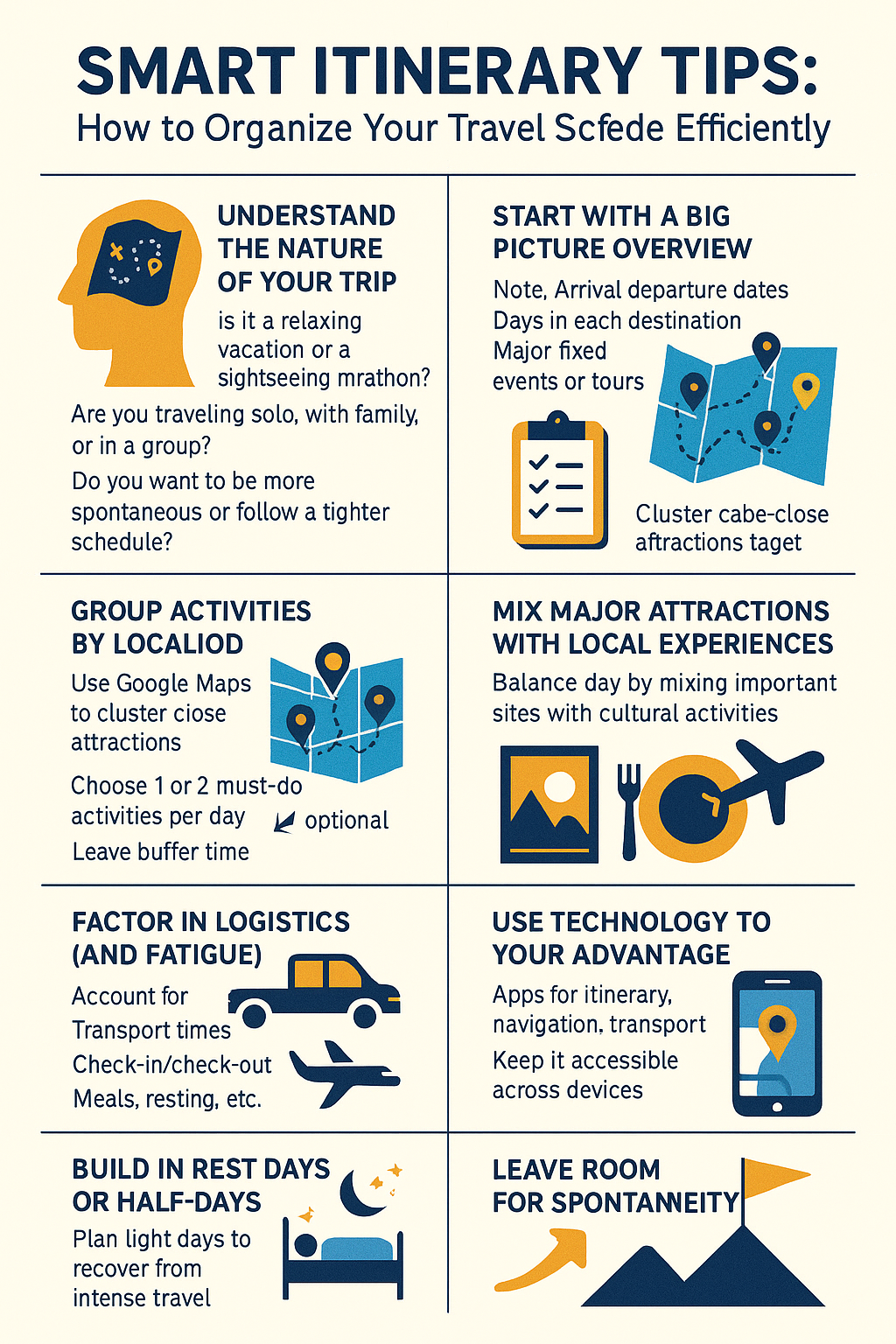An efficient travel itinerary can be the difference between a chaotic experience and a well-paced, unforgettable journey. Planning too much can lead to burnout, while too little planning may leave you wasting time. Whether you’re exploring one city or multiple countries, organizing your itinerary the smart way helps you make the most of your time and budget.
Here’s how to build a practical, flexible, and efficient travel schedule—step by step.
Understand the Nature of Your Trip
Before diving into maps and calendars, define the overall vibe and pace of your trip:
- Is it a relaxing vacation or a sightseeing marathon?
- Are you traveling solo, with family, or in a group?
- How many destinations are involved?
- Do you want to be more spontaneous or follow a tighter schedule?
Your answers help set realistic expectations and define how detailed your itinerary should be.
Start with a Big Picture Overview
Use a simple calendar or planner to create a macro view of your trip. Begin by noting:
- Your arrival and departure dates
- Number of days in each destination
- Travel time between locations
- Major events or tours that are fixed in time
This framework allows you to see where your time is most limited or flexible, helping you prevent overbooking or long stretches with nothing to do.
Group Activities by Location
Once your destinations are set, group attractions and experiences by geographic proximity:
- Use Google Maps to pin your points of interest
- Cluster them into regions or neighborhoods
- Schedule activities that are close together on the same day
This minimizes unnecessary travel time and avoids backtracking, which saves time and energy.
Prioritize, Don’t Overload
You don’t have to see everything. In fact, trying to fit too much into each day leads to exhaustion and frustration. Instead:
- Choose 1 or 2 must-do activities per day
- Add optional activities if time and energy allow
- Leave buffer time for relaxation, meals, and surprises
Travel is more enjoyable when you allow moments for spontaneity.
Mix Major Attractions with Local Experiences
Tourist landmarks are often time-consuming and crowded. Balance your day by mixing:
- A major site (museum, famous landmark, guided tour)
- A relaxing or cultural activity (local café, street market, park)
- A meal in a local restaurant or food stall
This rhythm makes each day more enjoyable and immersive without being overwhelming.
Factor in Logistics (and Fatigue)
Always account for:
- Transport times (including waiting, boarding, delays)
- Check-in and check-out windows for hotels
- Time needed for packing, resting, and eating
Even short train rides or flights can consume more hours than expected when you factor in logistics.
Pro Tip: Always assume things will take 15–30% longer than planned.
Use Technology to Your Advantage
Apps can save you hours and help you stay on track:
- Google Maps for navigation and pins
- TripIt or Sygic Travel for itinerary management
- Rome2Rio to explore transportation options
- Notion, Evernote, or Google Docs to keep flexible notes
- WhatsApp for local communication and bookings
Keep your itinerary accessible across devices, especially offline if you’re going to remote areas.
Build In Rest Days or Half-Days
If your trip lasts more than five days, plan a rest day or light day:
- Sleep in, do laundry, or simply wander with no set goal
- Avoid booking tours or major travel on these days
- Use it to recover from long-haul flights or adjust to time zones
Your future self will thank you.
Confirm Bookings and Double-Check Details
A well-planned itinerary includes all necessary confirmations:
- Accommodation names, addresses, check-in/check-out times
- Tour or activity bookings with time and meeting points
- Flight/train/bus times and terminals
- Tickets, passes, or QR codes stored both online and offline
Having everything consolidated prevents miscommunication or last-minute surprises.
Leave Room for Spontaneity
Your itinerary is a guide, not a prison. Some of the best travel memories happen when you:
- Chat with locals and get unexpected recommendations
- Discover hidden cafes or street performances
- Stay longer at a place that surprises you
Try to leave at least 20–30% of your trip unscheduled.
An Itinerary is a Tool, Not a Rule
A smart itinerary doesn’t mean a packed calendar—it means making intentional choices that give your trip direction, balance, and flexibility. With the right planning mindset, you’ll reduce stress and increase joy, making your travel experience not just productive, but truly memorable.
Plan smart, move freely, and embrace the unexpected—because that’s when real adventures begin.
